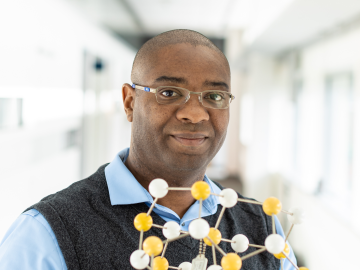Filter News
Area of Research
- (-) Biology and Environment (35)
- (-) Fusion Energy (8)
- (-) Materials (102)
- (-) Supercomputing (35)
- Advanced Manufacturing (9)
- Biological Systems (1)
- Clean Energy (111)
- Computational Biology (1)
- Computational Engineering (1)
- Computer Science (3)
- Electricity and Smart Grid (1)
- Fusion and Fission (8)
- Isotope Development and Production (1)
- Isotopes (4)
- Materials Characterization (2)
- Materials for Computing (17)
- Materials Under Extremes (1)
- National Security (11)
- Neutron Science (35)
- Nuclear Science and Technology (10)
- Nuclear Systems Modeling, Simulation and Validation (1)
- Quantum information Science (1)
- Sensors and Controls (2)
- Transportation Systems (2)
News Type
News Topics
- (-) Advanced Reactors (9)
- (-) Bioenergy (25)
- (-) Biomedical (15)
- (-) Grid (7)
- (-) Materials (56)
- (-) Materials Science (58)
- (-) Security (4)
- (-) Transportation (13)
- 3-D Printing/Advanced Manufacturing (23)
- Artificial Intelligence (16)
- Big Data (7)
- Biology (32)
- Biotechnology (7)
- Buildings (4)
- Chemical Sciences (24)
- Clean Water (4)
- Climate Change (22)
- Composites (8)
- Computer Science (53)
- Coronavirus (13)
- Critical Materials (15)
- Cybersecurity (7)
- Decarbonization (9)
- Energy Storage (28)
- Environment (40)
- Exascale Computing (8)
- Frontier (13)
- Fusion (11)
- High-Performance Computing (22)
- Hydropower (3)
- Isotopes (7)
- ITER (1)
- Machine Learning (8)
- Mercury (1)
- Microscopy (19)
- Molten Salt (3)
- Nanotechnology (31)
- National Security (5)
- Net Zero (2)
- Neutron Science (29)
- Nuclear Energy (11)
- Partnerships (9)
- Physics (19)
- Polymers (13)
- Quantum Computing (9)
- Quantum Science (21)
- Renewable Energy (1)
- Simulation (6)
- Space Exploration (3)
- Summit (22)
- Sustainable Energy (24)
- Transformational Challenge Reactor (1)
Media Contacts

ORNL’s Debangshu Mukherjee has been named an npj Computational Materials “Reviewer of the Year.”

Led by Kelly Chipps of ORNL, scientists working in the lab have produced a signature nuclear reaction that occurs on the surface of a neutron star gobbling mass from a companion star. Their achievement improves understanding of stellar processes generating diverse nuclear isotopes.
Oak Ridge National Laboratory scientists led the development of a supply chain model revealing the optimal places to site farms, biorefineries, pipelines and other infrastructure for sustainable aviation fuel production.

Anne Campbell, an R&D associate at ORNL, has been selected for an Emerging Professional award from ASTM International. ASTM, formerly the American Society for Testing and Materials, is an international standards organization that develops and publishes voluntary consensus technical standards for a wide range of materials, products, systems and services.

Valentino “Tino” Cooper, a scientist at ORNL, has been appointed to DOE’s Basic Energy Sciences Advisory Committee for a three-year term. Cooper’s research elucidates the fundamental understanding of advanced materials for next-generation energy and information technologies.

Andrew Lupini, a scientist and inventor at ORNL, has been elected Fellow of the Microscopy Society of America.

Oak Ridge National Laboratory scientists exploring bioenergy plant genetics have made a surprising discovery: a protein domain that could lead to new COVID-19 treatments.

Ho Nyung Lee, a condensed matter physicist at the Department of Energy’s Oak Ridge National Laboratory, has been elected a Fellow of the Materials Research Society.

A new report published by ORNL assessed how advanced manufacturing and materials, such as 3D printing and novel component coatings, could offer solutions to modernize the existing fleet and design new approaches to hydropower.

ORNL researchers have identified specific proteins and amino acids that could control bioenergy plants’ ability to identify beneficial microbes that can enhance plant growth and storage of carbon in soils.




